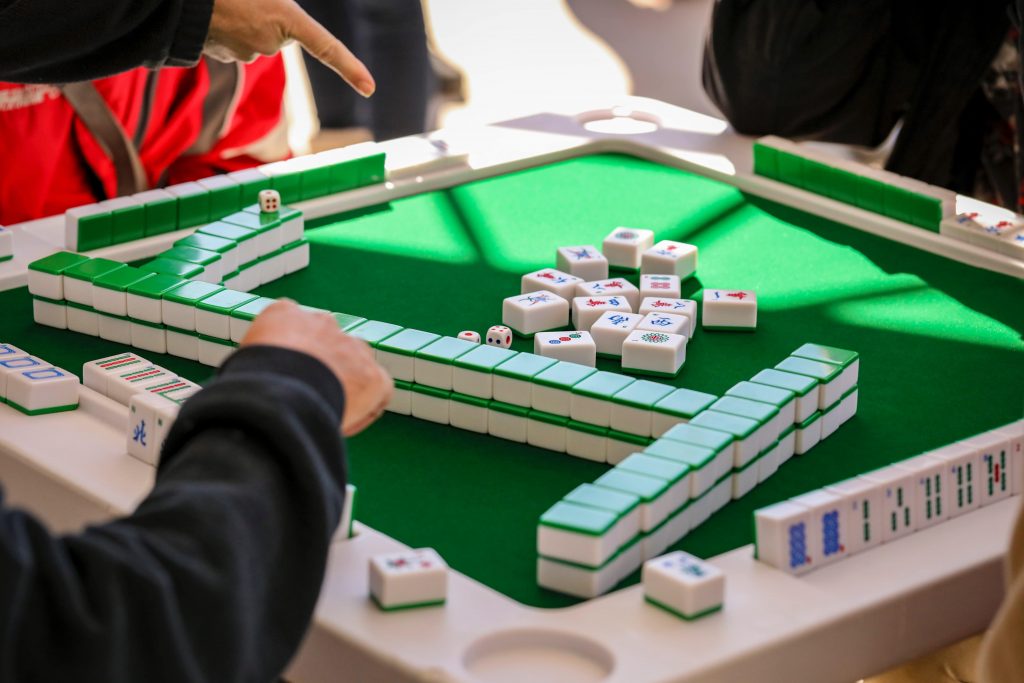
Mahjong is one of the forms of entertainment in Chinese society. Playing mahjong can help strengthen communication skills and exercise the brain’s ability to think and memorise for the elderly. The research done by Zhang et al. in 2020 showed that playing Mahjong for 12 weeks improved the executive function of older adults with mild cognitive impairment (MCI). Because Mahjong is a simple, low-cost entertainment activity, it could be widely applied to slow down or reverse the progression of
cognitive decline in people with Mild Cognitive Impairment (MCI), including those with traumatic brain injury. Malaysia Mahjong is one of the variants of Mahjong. It is different from traditional four-player mahjong as it is easier to play and end the game. There are a total of 84 tiles.
There is no fixed rule on how to play; the direction depends a lot on the people who are going to play, as long as everyone agrees to it. Practices will be decided before starting to play the game. For example, while parents are playing with their children, they might not care about how many “fans” or points you have (basically, to win will need a minimum of 5 fans) as
long as you can make your mahjong piece in hand with 3 or 4 identical or consecutive sequence dot tiles and a pair of matching tiles.
Is Mahjong learnable for elderly?
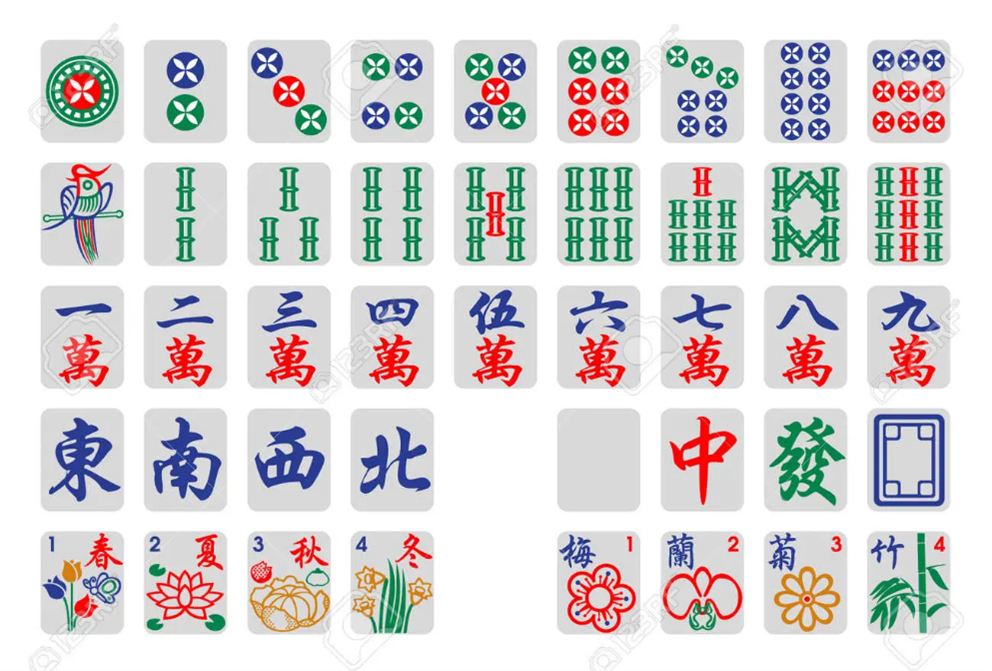
Mahjong is very easy to learn, especially following Malaysian rules. I learned how to play it when I was in secondary school. In order to end the game, it requires combining the tiles into a different suit. The game is played with a set of 84 tiles based on Chinese symbols and characters such as dots, honours and bonuses, and there are four pieces for each type of tile. It is easy to recognise the tile:
1) A dot tile with one dot until nine dots. Generally, you would need to match dot tiles with the same number or a consecutive sequence like one, two, and three dots.
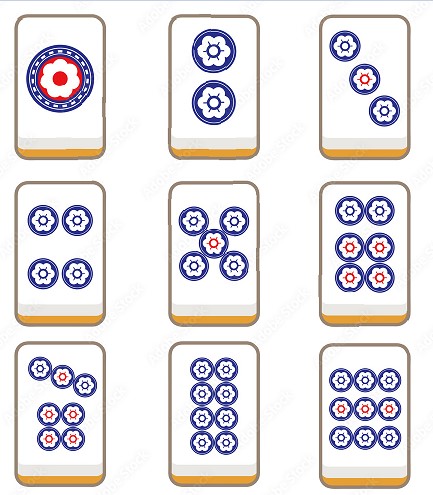
2) An honours tile shows a word element such as East (东), South (南), West (西), North(北), Red (中), Green (發), and White Dragons (look like window or door).
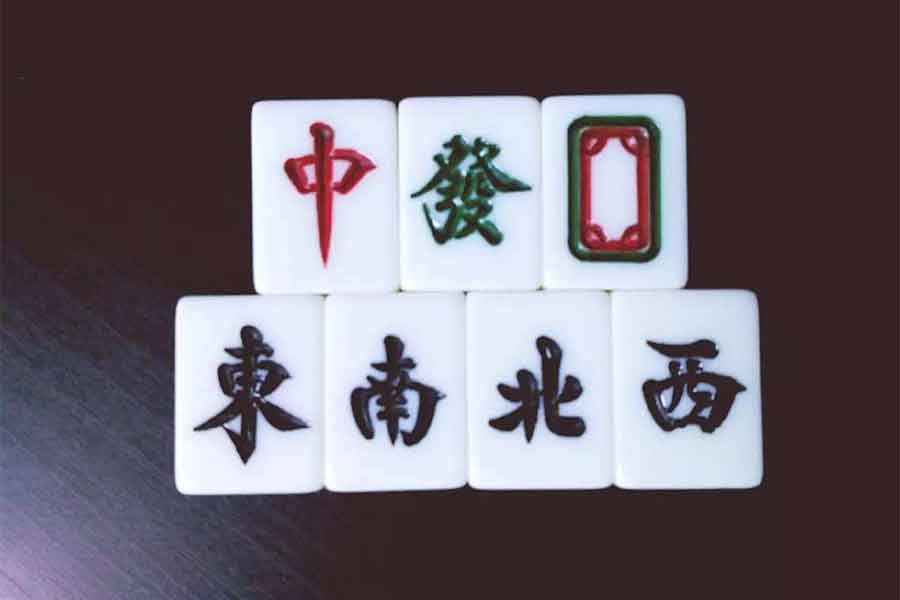
3) A bonus tile looks like a flower, season, face, or animal. This tile needs to be revealed in front of others to get a bonus fan. This tile does not require any composition.
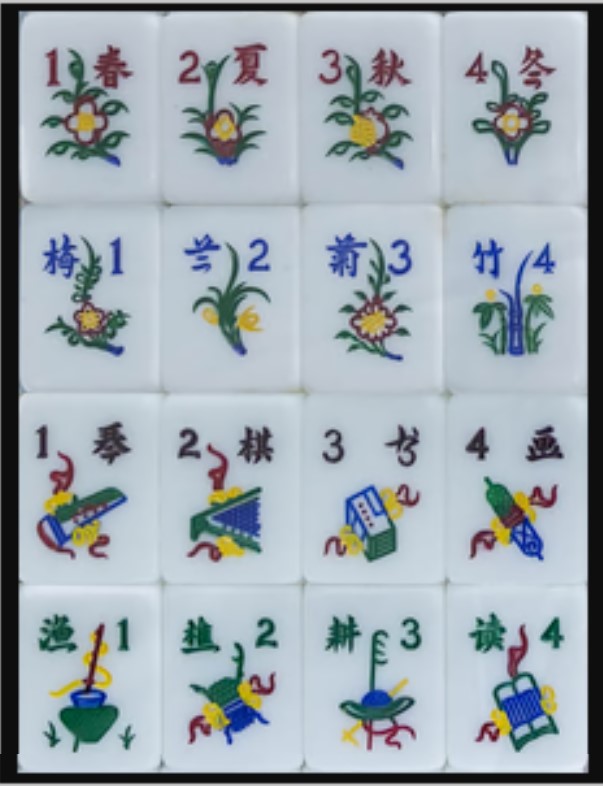
4) The last type of tile is the joker tile called “fei”. It can represent any tile you want.
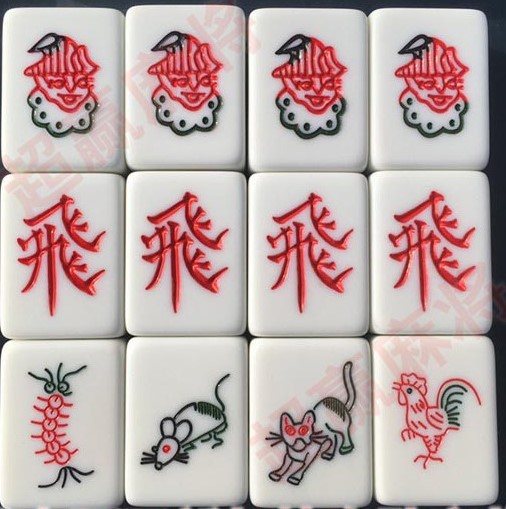
Not able to recognise the tiles? What can you do?
It is okay if you are not familiar with the function of each tile, I will provide some tips for you. If you are a beginner, I will recommend you to follow the procedure below:
1. Find your partner
This game requires three players, a mahjong set and a square or triangular table to seat three. On each side only sit one person. You can ask your friends to guide you.
2. The tiles need to be shuffled by players and rearranged the tiles into the three-row wall
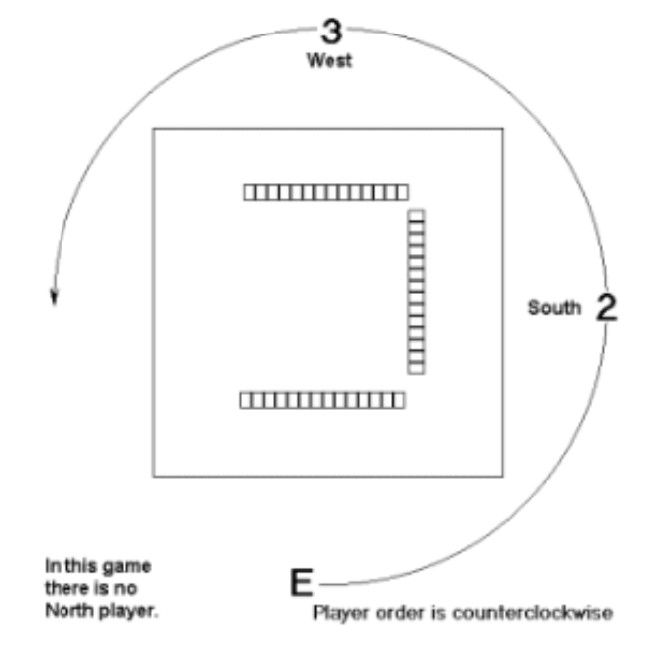
(Source: sloperama.com)
After shuffling, each player must arrange the tile into the one-row wall and put it in front of you. The row wall contains fourteen tiles stacked on top of another fourteen tiles. So, it will be a total of twenty-eight tiles. It should look like the image shown above.
3. Roll the two dice!!!
Roll the two dice to decide who plays first. The player with the highest points will be the first player. After deciding on the first player, the first player must roll the dice again to decide on the second dice roller. The result is counted counterclockwise, counting one starting from the first player who throws the dice. Sum up the points from the first and second dice rollers.
4. Take your tiles
After you sum up both results, you count stack by stack, following clockwise starting from the rightmost pile of the second dice roller row wall. Then, you will begin to take two stacks, meaning you will have four tiles each time you take them. Take the stacks after the summation of points of both throws. For example, if the first person throws five, the second person throws nine, and the summation would be fourteen. Then the first player starts taking fifteen and sixteen stacks. The second player will take the seventeen and eighteen stacks, followed by the third. After each player takes the stacks three times, the first player will need to skip one stack to get the next tile. This means that in the fourth time of taking the tiles, draw one tile from the first stack, then skip the second stack to get one tile from the third stack. The second player takes the bottom tile from the first stack, while the third player takes the top tile from the second stack. Each person will have 13 tiles in this case, except the first player will have 14 tiles.
Tip: If you are the first player, the person sitting on your right-hand side is the second player, called soul.
5. Reveal all your bonus tiles
Before starting the game, every player needs to reveal all their bonus tiles in front of them and take the replacement tiles from the backend (opposite the front end of where you initially take your tiles from) of the row wall. The tile with four identical tiles also needs to be revealed, and take one replacement tile after the bonus tile. The game will start with the first player discarding the tile he does not need.
Tip: Regardless of the bonus tile or four identical tiles, always draw the replacement tile from the backend of the row wall.
6. Take your turn to draw or discard a tile to win
While playing the game, each of the players can take turns drawing and discarding tiles. Drawing the tile starts from the front end of the row wall and is drawn following a clockwise direction. To win, you must form four suits and a pair containing two identical tiles. You can also find suits through a combination called “chi” which refers to the suit of consecutive tiles like two, three, and four dots tiles are considered a suit. You can also “pong” when other players discard the same tile that you happened to have one pair. For instance, if you have one pair of five dots tile, and another player discards the five dots tile, you can shout “pong” to take the tile. Then you can form a case with three identical tiles. You can also shout “gong” if you already have three tiles with the same pattern and another player discard the fourth identical tile. Remember to take a replacement tile from the back end after that.
To sum up, in order to create a suit, you can take the tile that is discarded by the previous player or drawn from the row wall.
You are allowed to “pong” and “gong” to take the tile discarded from another two players, but you are only allowed to form “chi” from the tile discarded from your previous player and not the one before your previous player. Both statements are based on the assumption that you are not drawing the identical tile yourself and you want to take the tile from others.
Sometimes, not every player gets the turn to play in each round. You might be skipped because the player after you “pong” or “gong” to get the discarded tile from the previous player. Thus, you may need to pass the turn to that player.
If you are already familiar with the mahjong game, you may add the “fan” (points) rule, which will be stated at the end of this article. The number of “fans” consists of each type of suit and is displayed as a table easy for your reference.
Tips for Beginners To Play Mahjong!
To win a mahjong game typically depends on your luck, which tiles you take, and what your hand look like. But, it also depends on post-strategy:
• Have a clear plan – Look at the tiles in your hand, be ready with what composition you want to make and pick the tiles that are helping you top form suit.
• Don’t grab the first discard – Normally, we will not take the first discarded card unless the tile can let you immediately win. If not, drawing a tile from the row wall is recommended. This is because if you grab it, other players may be able to guess what tile you want.
• Set your tile at least a pair – It is always great making your hand by having a pair of tiles. A pair tile is always a good start to make pong, kong, or win. It also makes you clear what tile you need.
• Please avoid having a gap in your tile – Having a gap might easy provide information to other players about your current situation. Based on the gaps, they can guess your progress to win.
• Pay attention to the tiles that have been revealed on the table – This method helps you be aware of the potential to form a suit in your hand. For example, if more than two red dragon tiles are shown on the table, you need to be aware that red (中) dragon tiles are no longer impossible to form a pong or kong, as you may choose to discard them.
Fan Count Table - A More General Rule
*To win a game, the player should have a minimum of five fans (score) and above; 10 fans and above is called max fan.
Composition | Number of fun |
Animal and face | One fan each |
Own number of season | One fan each [Eg: The |
Number 4 season and | One fan each |
Pong of North or East | One fan each [East |
Pong of own wind | One fan |
Pong of Dragon | One fan for each pong |
2 Pong and a pair of | Three fan |
Mixed one suit | One fan |
3 Kong of South, East | Five fan |
3 Pong of South, East | Three fan |
The same suit only | Three fan |
4 Pong and a pair of | Five fan |
Suit with consecutive | Four fan |
Pong of 4 wind | Max fan |
3 Pong and a pair of | Max fan |
Four tiles of “fly.” | Max fan |
3 Pong of dragons | Max fan |
4 Kong | Max fan |
16 flower and season | Max fan |
Wining with first or | Max fan |
No flower, face, | Max fan |
*Subject to change as each place may have its own rules
I hope you are enjoying it. Mahjong is beneficial to mental and physical health, but it is not recommended to play for too long or become too addicted to it. It is possible to develop health problems, such as psoas muscle strains and neurasthenia, or worsen existing illnesses if you continue to play for an extended period. Always take a rest after the end of one game.
Source of Mahjong Image and gif
https://zh.wikipedia.org/zh-my/%E9%A6%AC%E4%BE%86%E8%A5%BF%E4%BA%9E%E4%B8%89%E4%BA%BA%E9%BA%BB%E9%9B%80 https://www.123rf.com/photo_143062594_mahjong-tiles.html
https://giphy.com/gifs/netflix-spike-lee-shes-gotta-have-it-sghi-ZaJtnTY8tFZz0PvmW9
https://giphy.com/gifs/Allwouldenvy-awe-mahjong-allwouldenvy-QHqkVq0yjWLolZiWEh
Reference
https://www.sloperama.com/mahjongg/malaysian.html
https://en.wikipedia.org/wiki/Three_player_mahjong#:~:text=Three%2Dplayer%20mahjong%20is%20a,from%20the%20more%20standard%20variations.
https://www.ncbi.nlm.nih.gov/pmc/articles/PMC7120035/#:~:text=Mahjong%20is%20a%20popular%20form,%2C%20mental%2C%20and%20manual%20activities.
https:/www.youtube.com/watch?v=qpYF-xmNMew
https://bargames101.com/mahjong-strategies/